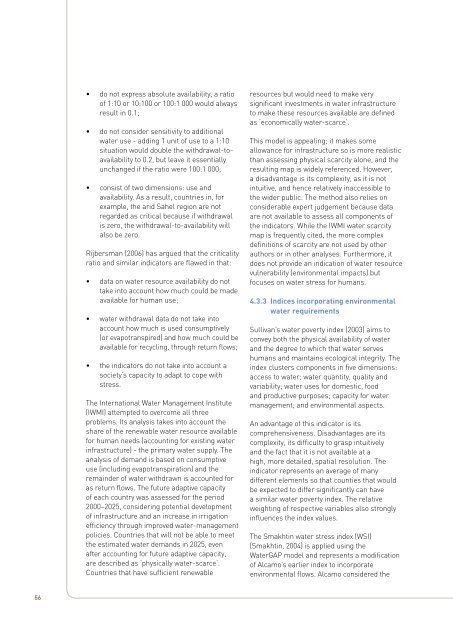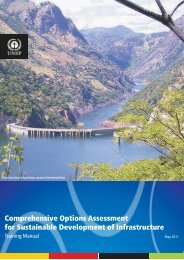MEASURING WATER USE IN A GREEN ECONOMY - UNEP
MEASURING WATER USE IN A GREEN ECONOMY - UNEP
MEASURING WATER USE IN A GREEN ECONOMY - UNEP
You also want an ePaper? Increase the reach of your titles
YUMPU automatically turns print PDFs into web optimized ePapers that Google loves.
• do not express absolute availability, a ratio<br />
of 1:10 or 10:100 or 100:1 000 would always<br />
result in 0.1;<br />
• do not consider sensitivity to additional<br />
water use - adding 1 unit of use to a 1:10<br />
situation would double the withdrawal-toavailability<br />
to 0.2, but leave it essentially<br />
unchanged if the ratio were 100:1 000;<br />
• consist of two dimensions: use and<br />
availability. As a result, countries in, for<br />
example, the arid Sahel region are not<br />
regarded as critical because if withdrawal<br />
is zero, the withdrawal-to-availability will<br />
also be zero.<br />
Rijbersman (2006) has argued that the criticality<br />
ratio and similar indicators are flawed in that:<br />
• data on water resource availability do not<br />
take into account how much could be made<br />
available for human use;<br />
• water withdrawal data do not take into<br />
account how much is used consumptively<br />
(or evapotranspired) and how much could be<br />
available for recycling, through return flows;<br />
• the indicators do not take into account a<br />
society’s capacity to adapt to cope with<br />
stress.<br />
The International Water Management Institute<br />
(IWMI) attempted to overcome all three<br />
problems. Its analysis takes into account the<br />
share of the renewable water resource available<br />
for human needs (accounting for existing water<br />
infrastructure) - the primary water supply. The<br />
analysis of demand is based on consumptive<br />
use (including evapotranspiration) and the<br />
remainder of water withdrawn is accounted for<br />
as return flows. The future adaptive capacity<br />
of each country was assessed for the period<br />
2000–2025, considering potential development<br />
of infrastructure and an increase in irrigation<br />
efficiency through improved water-management<br />
policies. Countries that will not be able to meet<br />
the estimated water demands in 2025, even<br />
after accounting for future adaptive capacity,<br />
are described as ‘physically water-scarce’.<br />
Countries that have sufficient renewable<br />
resources but would need to make very<br />
significant investments in water infrastructure<br />
to make these resources available are defined<br />
as ‘economically water-scarce’.<br />
This model is appealing; it makes some<br />
allowance for infrastructure so is more realistic<br />
than assessing physical scarcity alone, and the<br />
resulting map is widely referenced. However,<br />
a disadvantage is its complexity, as it is not<br />
intuitive, and hence relatively inaccessible to<br />
the wider public. The method also relies on<br />
considerable expert judgement because data<br />
are not available to assess all components of<br />
the indicators. While the IWMI water scarcity<br />
map is frequently cited, the more complex<br />
definitions of scarcity are not used by other<br />
authors or in other analyses. Furthermore, it<br />
does not provide an indication of water resource<br />
vulnerability (environmental impacts) but<br />
focuses on water stress for humans.<br />
4.3.3 Indices incorporating environmental<br />
water requirements<br />
Sullivan’s water poverty index (2003) aims to<br />
convey both the physical availability of water<br />
and the degree to which that water serves<br />
humans and maintains ecological integrity. The<br />
index clusters components in five dimensions:<br />
access to water; water quantity, quality and<br />
variability; water uses for domestic, food<br />
and productive purposes; capacity for water<br />
management; and environmental aspects.<br />
An advantage of this indicator is its<br />
comprehensiveness. Disadvantages are its<br />
complexity, its difficulty to grasp intuitively<br />
and the fact that it is not available at a<br />
high, more detailed, spatial resolution. The<br />
indicator represents an average of many<br />
different elements so that counties that would<br />
be expected to differ significantly can have<br />
a similar water poverty index. The relative<br />
weighting of respective variables also strongly<br />
influences the index values.<br />
The Smakhtin water stress index (WSI)<br />
(Smakhtin, 2004) is applied using the<br />
WaterGAP model and represents a modification<br />
of Alcamo’s earlier index to incorporate<br />
environmental flows. Alcamo considered the<br />
56

















